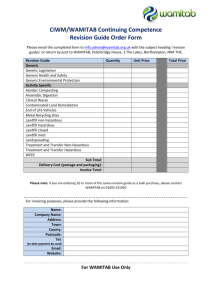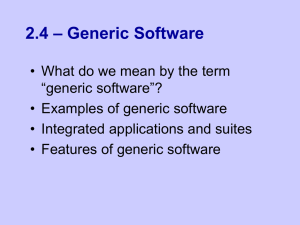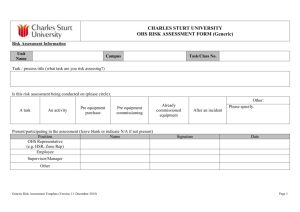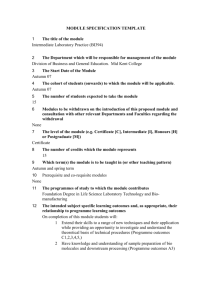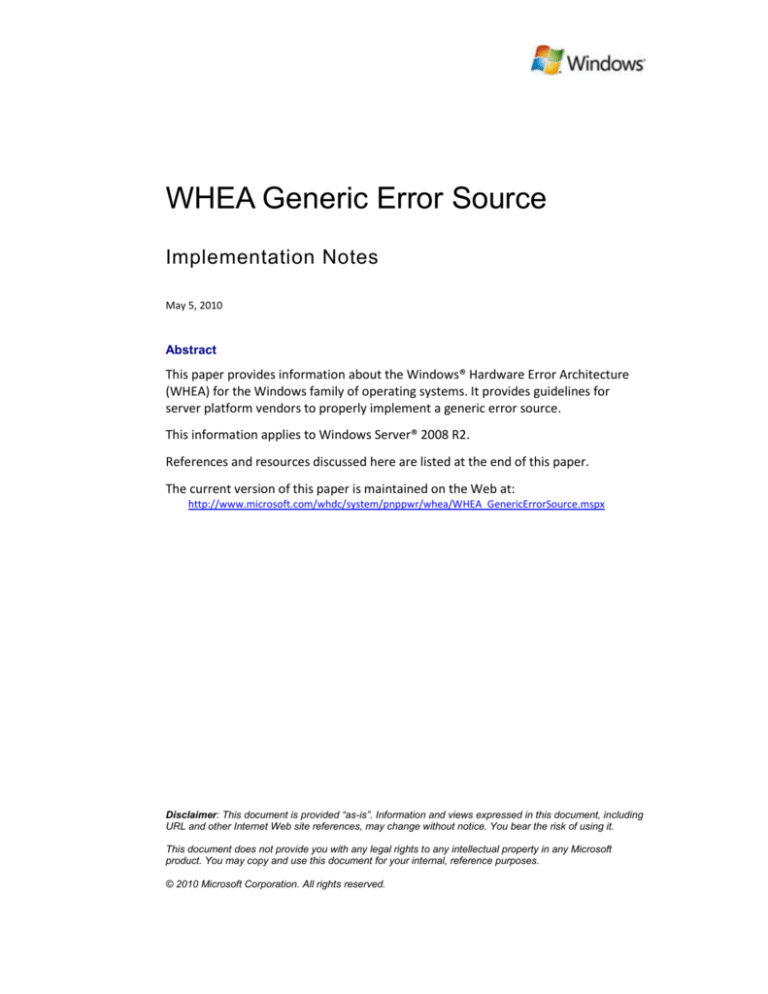
WHEA Generic Error Source
Implementation Notes
May 5, 2010
Abstract
This paper provides information about the Windows® Hardware Error Architecture
(WHEA) for the Windows family of operating systems. It provides guidelines for
server platform vendors to properly implement a generic error source.
This information applies to Windows Server® 2008 R2.
References and resources discussed here are listed at the end of this paper.
The current version of this paper is maintained on the Web at:
http://www.microsoft.com/whdc/system/pnppwr/whea/WHEA_GenericErrorSource.mspx
Disclaimer: This document is provided “as-is”. Information and views expressed in this document, including
URL and other Internet Web site references, may change without notice. You bear the risk of using it.
This document does not provide you with any legal rights to any intellectual property in any Microsoft
product. You may copy and use this document for your internal, reference purposes.
© 2010 Microsoft Corporation. All rights reserved.
WHEA Generic Error Source - 2
Document History
Date
May 5, 2010
Change
First publication
Contents
Introduction ................................................................................................................... 3
Generic Error Source ...................................................................................................... 3
Error Status Block ........................................................................................................... 4
Notification Methods ..................................................................................................... 7
Resources ....................................................................................................................... 7
May 5, 2010
© 2010 Microsoft Corporation. All rights reserved.
WHEA Generic Error Source - 3
Introduction
The Windows® Hardware Error Architecture (WHEA) is the foundation for hardware
error handling on Windows operating systems. WHEA provides interfaces for the
platform and Windows to collaborate on hardware error identification, reporting and,
if possible, recovery. Reporting hardware errors through WHEA enables the platform
to use the features of the Windows operating system to provide error logging
functionality and to integrate with management software. In addition, the
collaboration between the platform and Windows for error recovery provides
continuous system availability to the end user.
The notion of a hardware error source is a fundamental concept of WHEA. A
hardware error source is any hardware unit that alerts the operating system to the
presence of a hardware error condition. Examples of hardware error sources include
processor machine check exceptions, chipset error signals, I/O bus errors, and I/O
device errors. A single hardware error source might handle error reporting for more
than one type of hardware error condition. For example, a processor’s machine check
exception typically reports processor errors, cache and memory errors, and system
bus errors.
WHEA includes low-level hardware error handlers (LLHEHs) for standard hardware
error sources that exist on most platforms, such as those that were previously
mentioned. WHEA is also extensible so that it can support other types of hardware
errors or error reporting mechanisms through the use of a generic error source. A
generic error source provides a mechanism for the platform to report these hardware
errors to Windows. The generic error source support in Windows Server 2008 R2
complies with both the WHEA Platform Design Guide and revision 4.0 of the
Advanced Configuration and Power Interface (ACPI) specification. This paper provides
clarification to the information in the WHEA Platform Design Guide and the ACPI
specification for implementing a generic error source.
For more information about WHEA, see “WHEA – Windows Hardware Error
Architecture” on the WHDC website. See also the WHEA Platform Design Guide,
which is available to Microsoft partners under NDA, and section 17 of the ACPI
specification, revision 4.0.
Generic Error Source
The platform enumerates its error sources, including the generic error source, by
using the ACPI hardware error source table (HEST). The HEST is described in Table 4.1
of the WHEA Platform Design Guide and in Table 17.3 of the ACPI specification,
revision 4.0. The platform uses a generic error source to implement one or more of
the following types of error sources:
An error source that notifies the operating system of the presence of an error
condition by using a nonstandard notification mechanism. For example, such an
error source might use a system control interrupt (SCI).
An error source in which the information that is associated with an error
condition is encoded in a nonstandard format.
May 5, 2010
© 2010 Microsoft Corporation. All rights reserved.
WHEA Generic Error Source - 4
An error source for which the platform implements firmware-first handling of an
error condition.
The implementation of a generic error source relies on a block of memory that is
shared between the platform and Windows. This block of memory is called the error
status block (ESB). The platform must allocate the memory for the ESB during system
startup, before the operating system is started. This memory should be marked as
firmware reserved in the memory map, which prevents the Windows memory
manager from using this memory for any other purpose. WHEA obtains the
information it needs to access the ESB from the Generic Hardware Error Source
Structure that is in the HEST. This structure is described in Table 4-12 of the WHEA
Platform Design Guide and in Table 17-11 of the ACPI specification, revision 4.0. This
structure specifies where WHEA can obtain the 64-bit physical memory location of
the ESB and the length of the ESB.
Note: There are two levels of indirection to obtain the physical address of the ESB
from the Generic Hardware Error Source Structure because the address information
in the Error Status Address field of the structure points to a 64-bit register and the
contents of that register points to the physical location of the ESB.
Error Status Block
The format of the ESB is described in Table 4-13 of the WHEA Platform Design Guide
and in Table 17-12 of the ACPI specification, revision 4.0. This paper discusses the
semantics of the format of the ESB rather than the details about each field.
Figure 1 shows the layout of the ESB in memory. Note that the ESB is reused every
time that the generic error source reports an error to WHEA.
Byte Offset
0
4
8
12
16
20
Block Status
Raw Data Offset
Raw Data Length
Data Length
Error Severity
Generic Error Data Entries
Raw Data Offset
ESB Length
Data Length
(optional gap - data is ignored)
Raw Data
(optional gap – data is ignored)
Figure 1. Generic error source ESB
May 5, 2010
© 2010 Microsoft Corporation. All rights reserved.
Raw Data
Length
WHEA Generic Error Source - 5
Figure 2 shows the layout of the ESB if no raw data is associated with the generic
error source.
Byte Offset
0
4
8
12
16
20
Block Status
0
0
Data Length
Error Severity
Generic Error Data Entries
ESB Length
Data Length
(optional gap - data is ignored)
Figure 2. Generic error source ESB that has no raw data
The following provides information about each ESB field that will help you to
correctly implement a generic error source.
Block Status
The Block Status field indicates what kind of error is reported in the ESB. The ESB
always reports a single correctable or uncorrectable error condition. However,
bits in the block status also indicate multiple correctable or uncorrectable errors.
These bits are only for informational use. For every generic error notification that
the platform sends to Windows, the error information that is reported in the ESB
results in a single error record, regardless of the state of the multiple error bits.
The number of generic error data entries in the ESB is also encoded in the Block
Status field. When an error is reported in the ESB, there must be at least one
generic error data entry in the ESB. The format of the Block Status field is
described in Table 4-13 of the WHEA Platform Design Guide and in Table 17-12 of
the ACPI specification, revision 4.0.
Note: An error exists in earlier versions of the WHEA Platform Design Guide and
in section 17.3.2.6.1 of the ACPI specification, revision 4.0. Both documents state
that the ESB can contain zero generic error data entries. This information is
incorrect. The ESB must contain at least one generic error data entry.
Raw Data Offset
The Raw Data field is an optional field of the ESB that contains data that is
opaque to Windows during error condition processing. This data is included in the
WHEA error packet in its original raw form. The Raw Data Offset field contains
the offset from the start of the ESB to the start of the raw data. If raw data is
present in the ESB, it must follow all generic error data entries. In this situation,
the Raw Data Offset field must be at least Data Length + 20. Note, however, that
the raw data is not required to immediately follow the generic error data entries.
This enables the platform to select the alignment of the raw data that is most
convenient for the platform.
If no raw data is present in the ESB, the Raw Data Offset and Raw Data Length
fields are both set to zero.
May 5, 2010
© 2010 Microsoft Corporation. All rights reserved.
WHEA Generic Error Source - 6
Raw Data Length
The length of the raw data must not exceed the value of the Max Raw Data
Length field of the Generic Hardware Error Source Structure. In addition, the
value of the Raw Data Offset field plus the value of the Raw Data Length field
must not exceed the value of the Error Status Block Length field of the Generic
Hardware Error Source Structure. The Generic Hardware Error Source Structure is
described in Table 4-12 of the WHEA Platform Design Guide and in Table 17-11 of
the ACPI specification, revision 4.0.
If no raw data is present in the ESB, the Raw Data Offset and Raw Data Length
fields are both set to zero.
Data Length
The Data Length field specifies the total size, in bytes, of all generic error data
entries in the ESB. As previously stated, the ESB must contain at least one generic
error data entry when an error condition is reported to Windows.
Error Severity
The Error Severity field of the ESB specifies the severity of the entire error event.
Each generic error data entry in the ESB also includes an Error Severity field,
which specifies the severity of the specific error data in the generic error data
entry.
Generic Error Data Entries
As previously stated, the ESB must contain at least one generic error data entry
when an error condition is reported to Windows. The format of the generic error
data entries is described in Table 4-14 of the WHEA Platform Design Guide and in
Table 17-13 of the ACPI specification, revision 4.0. All generic error data entries
are reported in a single WHEA error record. The ability to include multiple generic
error data entries for a single error condition enables the platform to include
information from related components that are relevant to the error in the ESB.
For example, if a PCI device indicates an error condition, the platform could use a
separate generic error data entry to include information about the state of the
PCI bridge for the particular PCI bus where the device is connected.
Raw Data
The Raw Data field is an optional field of the ESB that contains data that is
opaque to Windows during error condition processing. This data is included in the
WHEA error packet in its original raw form. The amount of raw data must not
exceed the value of the Max Raw Data field of the Generic Hardware Error Source
Structure. The Generic Hardware Error Source Structure is described in Table 4-12
of the WHEA Platform Design Guide and in Table 17-11 of the ACPI specification,
revision 4.0.
If no raw data is present in the ESB, the Raw Data Offset and Raw Data Length
fields are both set to zero.
May 5, 2010
© 2010 Microsoft Corporation. All rights reserved.
WHEA Generic Error Source - 7
Notification Methods
The Notification Structure field of the Generic Hardware Error Source Structure
specifies the notification mechanism that the platform uses for the generic error
source to notify Windows about an error condition. This field contains a Hardware
Error Notification Structure, which is described in Table 4-15 of the WHEA Platform
Design Guide and in Table 17-14 of the ACPI specification, revision 4.0. When
Windows receives notification of an error condition from the generic error source, it
reads the Block Status field of the ESB to determine the type of error that occurred.
Resources
ACPI Specification
http://www.acpi.info
WHEA – Windows Hardware Error Architecture
http://www.microsoft.com/whdc/system/pnppwr/WHEA/default.mspx
WHEA Platform Design Guide
Available to Microsoft partners under NDA.
May 5, 2010
© 2010 Microsoft Corporation. All rights reserved.

